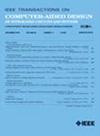Temperature Effects of Program Operation in 3-D nand Flash Memory: Observations, Analysis, and Solutions
IF 2.9
3区 计算机科学
Q2 COMPUTER SCIENCE, HARDWARE & ARCHITECTURE
IEEE Transactions on Computer-Aided Design of Integrated Circuits and Systems
Pub Date : 2025-02-07
DOI:10.1109/TCAD.2025.3539982
引用次数: 0
Abstract
As flash memory storage density continues to increase, it has become the mainstream storage medium for electronic devices. Writing data in low-temperature environment causes distortions in the flash memory threshold voltage distribution (TVD), which spikes the raw bit error rate and ultimately leads to degradation of the performance of flash-based electronic devices. To ameliorate the reliability problem caused by flash memory read and program temperature variations, this study proposes a flash memory programming temperature compensation algorithm based on read reference voltage (PTC-RRV) calibration. 3-D triple-level cell (TLC) flash memory is currently the mainstream storage medium for consumer electronics. Based on a large number of real tests on this type of chips, the relationship between the programming/reading temperature and the TVD of flash memory is fully characterized, and a programming temperature compensation model is constructed. The model evaluation results show that the PTC-RRV strategy can significantly reduce the average number of read-retry of low temperature written data and effectively improve the storage reliability and read performance of flash memory, whose optimization effect on electronic devices is better than the existing temperature compensation algorithms.3-D闪存中程序操作的温度效应:观察、分析和解决方案
随着闪存存储密度的不断提高,它已成为电子设备的主流存储介质。在低温环境下写入数据会引起闪存阈值电压分布(TVD)的畸变,从而导致原始误码率的急剧上升,最终导致基于闪存的电子设备的性能下降。为了改善闪存读取和程序温度变化带来的可靠性问题,本研究提出了一种基于读取参考电压(PTC-RRV)校准的闪存编程温度补偿算法。3-D三层单元(TLC)闪存是目前消费电子产品的主流存储介质。在对该类芯片进行大量实际测试的基础上,充分表征了编程/读取温度与闪存TVD之间的关系,并构建了编程温度补偿模型。模型评估结果表明,PTC-RRV策略可以显著降低低温写入数据的平均重试读次数,有效提高闪存的存储可靠性和读取性能,对电子器件的优化效果优于现有的温度补偿算法。
本文章由计算机程序翻译,如有差异,请以英文原文为准。
求助全文
约1分钟内获得全文
求助全文
来源期刊
CiteScore
5.60
自引率
13.80%
发文量
500
审稿时长
7 months
期刊介绍:
The purpose of this Transactions is to publish papers of interest to individuals in the area of computer-aided design of integrated circuits and systems composed of analog, digital, mixed-signal, optical, or microwave components. The aids include methods, models, algorithms, and man-machine interfaces for system-level, physical and logical design including: planning, synthesis, partitioning, modeling, simulation, layout, verification, testing, hardware-software co-design and documentation of integrated circuit and system designs of all complexities. Design tools and techniques for evaluating and designing integrated circuits and systems for metrics such as performance, power, reliability, testability, and security are a focus.

 求助内容:
求助内容: 应助结果提醒方式:
应助结果提醒方式:


